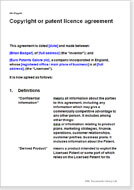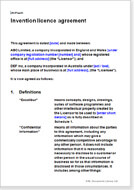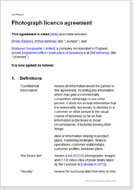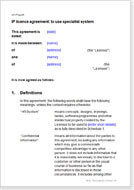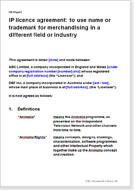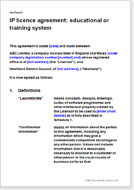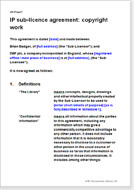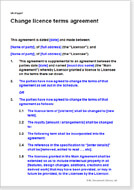Intellectual property licence agreements
These agreements allow the licensee to use written text, software, images, music, inventions, designs, systems, plans, objects or any other intellectual property in as wide or narrow a range of circumstances as you choose. These are flexible contracts that protect your interest and enable a smooth and reasonable deal.
Copyright licence agreement
This is a simple agreement to license work that you have created to someone else for a specific purpose.
It has a very wide possible application. For example, you might be:
- a writer, wishing to sell your articles to a newspaper
- a graphic designer, wanting to allow a website to use your cartoon artwork
- a musician, wanting to sell your music to a film producer
The agreement grants a licence, for a specified sum of money, for some other person to use your work. The licence may be set for a specific time period, or continue in perpetuity.
The document provides for sub-licence, i.e. for the person to whom you licence the work to licence it to others.
Copyright or patent licence agreement
The essence of this patent licence agreement is that it is a licence by an inventor or owner to a person or company who will market the patent to others to exploit in a given territory or industry.
The agreement can also be used for any other copyright work where you rely on sub-licences agreed and set up by someone else.
Your IP is something that cannot be used alone, but that must be incorporated into some other product, for example, a vibration dampening system for engines. Your licensor provides marketing help to sub-license the product to end manufacturers.
Payment could be upfront, by royalty or both.
Invention licence agreement
This is a comprehensive agreement to license intellectual property rights in an invention or technological innovation.
The nature of the invention is not important to the document. It could be a stand-alone product, a component for another product, or a device that improves an existing product.
The licensee is granted the right to manufacture or use the product in his own market, but not to sub-license or re-sell the IP to others. In other words, the licence can be limited to a particular market. That leaves the inventor free to grant more licences to others in other industries, or manufacture the product himself.
The licence is granted irrevocably (i.e. forever) so that the licensee can be sure that he and his customers are safe in buying from him.
The document covers:
- all intellectual property rights in every aspect of your work, for example: design drawings, copyright, software and patents
- optional support by the licensor – with a separate licence to use any support systems
- payment upfront, with the option of an additional royalty fee
Photograph licence agreement
This is a version of our standard copyright agreement, tailored (simplified) for licensing a photograph or video.
The licensor could be a professional or amateur photographer working in any medium.
The licensee could use the photo or film for any purpose you agree: on a website, in print, within a longer compilation of films.
The agreement includes options for:
- the licensee to sub-license in named countries
- the licensee must always acknowledge your rights
IP licence agreement: to use specialist system
This agreement licenses software, a system or a procedure to be incorporated into one or more other software systems or applications.
For example, you might have written an add-on module for a piece of software and now wish to grant use of your software to a large corporate end-user.
The document cannot be used to license the IP to a business that will then resell it or use it in a product for mass sale.
The agreement gives you options for:
- pricing: fee per user; an upfront fee; or continuous payments over time
- support: telephone support; periodic upgrades; bug fixing; e-mail response; consultation at an hourly rate
IP rights sale agreement: in chemical compound
This agreement provides the complete legal framework for a sale of rights in a chemical compound.
The compound could have uses in any industry (perhaps many) and could stand alone or be an ingredient in a yet more sophisticated product. For example, it could be a food preservative, or a type of coating for windows, or a pharmaceutical compound.
This agreement limits the sale to a particular market, industry, geographic place, or end product. That allows the seller to sell rights later for use in other industries or markets, or to manufacture it himself.
Payment can be by cash up front, and/or by continuing royalty or commission on sales.
The document provides for co-operation and help: paid or free. Because this co-operation may be essential, in this agreement neither party is favoured. We have included reasonable protection for both parties.
The agreement terminates on expiry of supporting patents or when generic versions become available or as you wish.
IP licence agreement: of technical product in a single industry or market
This is a heavyweight licence agreement for rights in an invention. It could be any technical IP. It can be limited in any way, including by industry, geography or application.
It is likely that the IP could be used in more than one industry, and that the owner or inventor will licence it widely, but to only one licensee per industry or sector
The licence is perpetual, irrevocable, non-exclusive, royalty-free and worldwide. The licensee is therefore entirely free to incorporate it into any product he makes, provided it is in his industry only.
The document also provides for the licensee additionally to obtains a secondary licence to some sort of supporting intellectual property (if appropriate to the deal). This is most likely to be a trademark or a patent. That right is also perpetual but it is limited so that the licensor can allow others to use it too. The licensor may grant this separately because he wishes to protect additional material more strongly because it may have far wider application, or because it contains IP that is not his own and to which he does not have rights to do anything else.
The deal is for a single payment up front.
Examples of applications:
- a carpet manufacturer invents new way to cut and mould carpet shapes to a room in one piece. He licenses the idea to a car finisher who patents it for use in cars, but in name of licensor
- a microchip designer creates a new chip that can process images much faster than any competitor product. He licenses the idea to two manufacturers: one of graphics cards in Europe, and a camera manufacturer in Asia
IP licence agreement: to use name or trademark for merchandising in a different field or industry
This is a heavyweight agreement for licensing the merchandising rights in any form of intellectual property.
The key element is that the licensee will exploit the IP in a different application or market.
The merchandising rights may be limited in some way, for example, to certain geographic regions or for certain applications.
The agreement could be used across different industries or markets or in the same one.
For example, this agreement might be used to license:
- a set of children's cartoon characters for use on the packaging for a food product
- a shampoo under a brand well known for cosmetics
- a sports brand for use at an event (the agreement allows for branded merchandise at the event also to be included)
You can choose whether the agreement continues for a long duration, or for the duration of a particular event such as a consumer show.
There is a choice as to whether payment should be upfront, a royalty based on sales or both. A licensor will often want a fixed sum up front, just in case the merchandiser is not as good as he claims.
The document differs from our other merchandising agreement by providing for:
- support by the licensor of additional licensed material, for example updates by the addition of new material. This additional material is not covered by the main licence, but rather subject to stricter protection. This may be because it could be used in the same market for other applications, or because it might need stronger protection because the licensor does not own all rights in it.
- protection of new IP derived from the original. For example, if the licence concerns children’s cartoon characters, the agreement can specify who owns rights to a new supporting character developed by the licensor.
IP licence agreement: educational or training system
This is a heavyweight licence agreement for an intangible product such as an educational or training system.
The IP in the product is likely to be a process. However, the IP may also include physical objects as well. Licensees may download components, or it may be delivered in hard copy.
This agreement covers the intellectual property rights in every aspect of the work: from designs to copyright and patents.
The IP may be applicable to one industry or many. The agreement allows the licensor to protect the intellectual property whilst licensing its use to many people or businesses.
Payment may be a single upfront one, a period licence fee (such as an annual fee), and/or a royalty based on a metric such as the number of users.
The licence may be granted for as long as you decide. It can be limited to a particular market or application or territory. Re-sale and sub-license are forbidden.
Included is an option for the licensor to provide additional supporting systems on a separate licence basis. For example, the licensor may provide updates, expansions or training in how to use the system.
This document could be used, for example:
- by a professional services organisation to license use of a distance learning system that it has developed to a training provider
- by a swimming instructor who has devised an 8 week summer-holiday programme for teaching children to swim and who wishes to licence that system to swimming pool operators
Book or music publishing agreement
This agreement licenses publication of a text or musical composition. Effectively, the author or composer sells the rights to sell the work further within limitations.
The document could be used by either an author or composer, or the publisher. It can be edited to give legal and commercial advantage to one side or the other. It covers protection for both sides in reasonable balance.
We have taken account of industry procedures in publishing, for example, for control of the publishing process, and for advertising.
The document includes:
- optional limitations on the extent of the licence
- provisions for subsidiary rights to be specified and further royalties paid
- options for all royalty calculations
- extensive provisions for royalty payment procedures, including option to inspect publisher’s accounts
- strong protection of author’s rights, including moral rights
- a control procedure in case of infringement by a third party
- preservation of the author's rights to sell the same material in different markets
IP sub-licence agreement: copyright work
This is a comprehensive and flexible sub-licence agreement of any copyright material or created work.
The subject matter being sub-licensed could be of any size, complexity and nature. For example, it could be a design blueprint, an image, or a film script.
This document could also be used in a commercial partnerships, for example to permit an affiliate or partner to use material that the business does not actually own but is on licence from the original creator.
The document:
- assumes that the sub-licensor has all the rights needed to enable him to exploit the licence he has bought
- assumes details of the IP licensed are contained in the original licence
- covers multiple products or versions
- allows for an exclusive or non-exclusive sub-licence, so that the licensor can license the IP to others
- provides for control and ownership of derived versions created by sub-licensee - who owns and in what circumstances
- provides options for support and upgrades by the licensor
- provides the option for the sub-licence to be assignable (transferable)
- provides that the principle option for payment is a periodic royalty. This can be changed easily to a cash payment or some other basis
Change licence terms agreement
This is a simple agreement to change one or more of the terms in an existing licence without having to redraw or renegotiate the whole deal afresh.
It can be used for any purpose except to change the parties to the original contract. For that, you need one of our IP transfer agreements.
You may use this document to:
- extend a licence period
- increase the geographic areas in which the licensee can use the intellectual property
If the changes are extensive, you should consider using a new document.
Both parties must agree to the changes.

If the document isn’t right for your circumstances for any reason, just tell us and we’ll refund you in full immediately.

We avoid legal terminology unless necessary. Plain English makes our documents easy to understand, easy to edit and more likely to be accepted.

You don’t need legal knowledge to use our documents. We explain what to edit and how in the guidance notes included at the end of the document.

Email us with questions about editing your document. Use our Lawyer Assist service if you’d like our legal team to check your document will do as you intend.

Our documents comply with the latest relevant law. Our lawyers regularly review how new law affects each document in our library.
License rights to use IP using these documents
These agreements allow you to grant use of your intellectual property to someone else whilst retaining ownership in the long term.
Intellectual property encompasses many types of created work, from images and designs to processes and systems. IP can even be a combination of other works.
However, the majority of deals in IP require similar provisions. So a licence of rights in a set of magazine articles is not dissimilar from a licence of design rights for manufacture. For that reason, our documents can be used for a very wide range of alternative deals and arrangements.
It follows that when you look for a document, look for a description that is similar to, or matches your deal, not just a title that references the same type of IP that you wish to license.
Who should use these documents?
These documents can be used by either the owner of the IP (most likely the creator) or the licensee.
Most contracts are written to favour the interests of one party over the other. However, most of these documents are written so as to be fair to both sides (even if one side is favoured). The reason is that any arrangement that is intended to be continuous for any period of time requires mutual co-operation.
Our guidance notes explain each paragraph so that you don’t need prior experience of licensing intellectual property to edit one of our documents.
Strong legal documents
We describe some of our documents as simple. That does not mean that the legal effect of the document is not strong, but rather that the document is uncluttered by supplementary provisions like options for support, sub licences, licence back, and so on.
Similarly, a “heavyweight” document contains many options. You are unlikely to use all of them, but they will bring to your attention ideas that you may not previously have considered. Of course, you can easily edit out those that you decide not to use.
Limiting the use of the licence you grant
All our documents allow you flexibility to grant a licence to use the IP subject to conditions that you decide.
For example, you could limit use in certain countries or for certain purposes.
Limiting the circumstances in which the IP can be used lets you license the same IP multiple times to different people or businesses in order to maximise the return on your work.
It also might the case that your work has a component that is the intellectual property of someone else, and that you don’t have a permit to sublicense it in certain circumstances.
What you will find in your document
So far as applicable, our documents cover:
Named people and products
In many documents we have given a fictitious name to a party or product. We do this to make it easier for you to follow what the document is about. Of course, you will need to edit the document to use your own comparable names or generic ones.
Complete legal framework and commercial structure
Every agreement provides a complete structure for a deal. We cannot mention every smallest point, but you can reckon that if you need it, we have thought of it. If you have special requirements we can always help further with our review service.
International deals
Our use of plain English and statement that English law applies will help you to create a document that holds water in any jurisdiction.
However, every country has its own laws, so we cannot guarantee what a judge in Panama or Portugal might say. However, you will always be able to terminate a Net Lawman agreement for breach of a term.
Support by the owner or creator to the licensee
Many arrangements to exploit intellectual property involve a prime deal concerning specific IP and also a secondary deal for ongoing support. Where this support may include a second licence for additional IP, we provide for it.
There are two reasons why you might wish to protect this additional support material more strongly:
- First, the supporting material may have far wider application. You might want to use it in the same market for other applications, or in other products and other markets.
- The second reason is that you may not own all the supporting material. You may yourself use in the material some IP that has been licensed to you from others. So all you can do is to sublicense under whatever conditions you can do so.
These terms can easily be edited to suit your deal, or be deleted if you do not require them.
Preserving moral rights
The right of a creator of a work to be recognised is enshrined in law. Nonetheless, we do mention it in many agreements.
Protecting your rights
Who must sign?
Unlike a manufacturer of physical products, a licensor of IP rights can be up against theft on a large scale. It is very easy for a single individual to steal your rights or disclose your secrets. When your deal is with a company, only that company is bound. If one of its employees steals your secrets, all you can do is rely on your copyright.
Copyright needs no registration and no rights need to be reserved. In law, you can simply prove that you are the originator and you have not given permission and you are home and dry in a court claim. But that leaves two problems:
- you do not want to have to go to court
- when someone beaches your copyright, your “work” is immediately spread around, making it far harder to control and to catch further thieves.
While no legal document can guarantee to prevent theft, there are three small points that will help you (all of which we include in our documents as appropriate):
- word the signature point so that the person signing also takes personal responsibility
- insist on a personal guarantee
- have the document signed by every member of the team who will be dealing with the work
What you can do in practice of course depends on what your IP is, how easily it is stolen and whether your counter-party will agree.
Who owns copyright?
You need to be aware that the law differs in the USA from the UK and most other Western countries.
As far as we are aware, in most countries, intellectual property created by an employee is owned by the employer.
However, ownership of IP created under a contract is far less clear. In the USA, they use a term “work made for hire” to describe work done by a person who is not an employee. All such work belongs to the creator. So if you contract with a US designer for artwork for your website, that work remains his and not yours. What you get is a permit to use it for ever, on your site.
In the UK, the position is unclear. It is therefore best, when you commission work from an originator, always to include the point that “the resulting work shall be the property of” you.
All rights reserved


